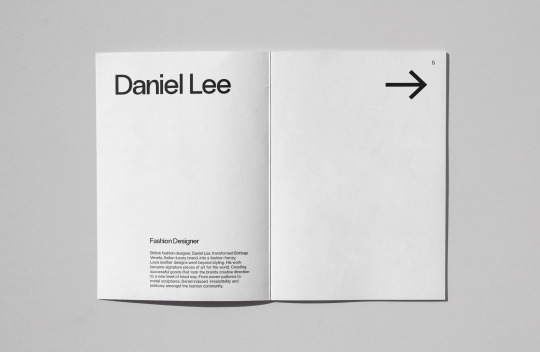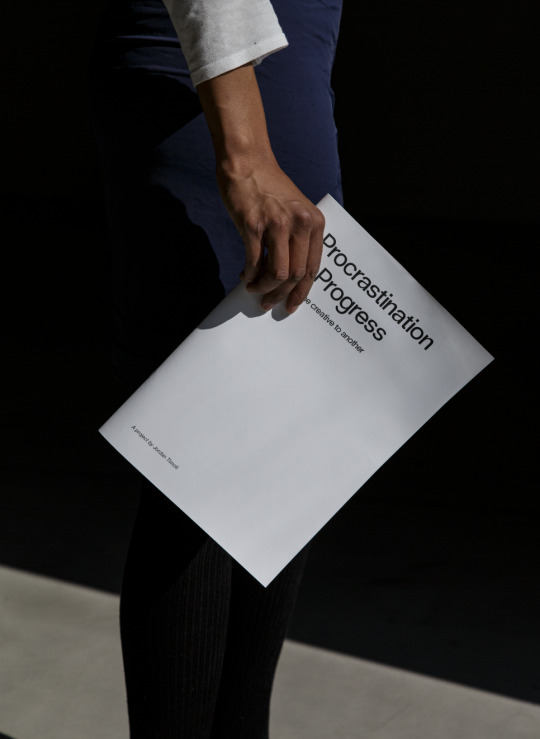Don't wanna be here? Send us removal request.
Text
Reflecting on my Exegesis:
Being a practice-led project the worked alongside our studio project what a challenge. Having being used to seperate assignments that don’t overlap to working so closely alongside each project struck as new territory. Being a designer who tends to struggle with literature and prefers to create rather than to write all research applied and gathered, I found it hard at to thoroughly articulate my studio project and correlate that to the exegesis research.
Looking at the design problem I created from a personal experience and struggle dealing with procrastination, meant I could use my own journey to tailor my artefact to a user like me. From the beginning of this design problem, I always knew I wanted to produce some form of inspiration. As I am attracted to tangible things, creating a publication was the ideal medium and gave me the chance to create a design solution that could also become a keepsake and hold longevity. Overall, I am proud the research I conducted and the way I translated that into an artefact as I believe there is clear evidence and connections between the two.
0 notes
Text
Exegesis Images:
As my contextual knowledge contained psychologic facts and definitions, I struggled finding any images that would be appropriate to include in my exegesis. In my methods and critical commentary where I discuss the application and use of techniques or strategies, I felt it would be worthwhile to incorporate images of my publication to give the reader/marker context of what I was explaining. I also placed my publication in some mockups to create more appeal and make the exegesis feel more design considered rather than a simple screenshot of my work off InDesign.



0 notes
Text
Test

As both the exegesis and the studio artefact are going to be called ‘Procrastination in Progress’ I felt it was important to maintain the same design system and aesthetic for cohesion. I applied the same typography hierarchy as well as a simpler layout to content although instead of being image heavy it will be text heavy.
0 notes
Text
Words I took down from listening to lecturers speak:
It might seem odd to some, but I very much like to pay attention to terminology when people speak. During one of our lectures when discussing the exegesis, I started bullet pointing words that seemed relevant and could correlate to my own writing. This not only helps my exegesis but betters my vocabulary as a practice-led designer.
Words:
Immerse
Technological
Innovations
Narrative
Social impacts
Characterisation
Conceptually
Environments
Shaped
Psychology-led
Explores
The nature of
Advancing
Inserted
Suspend
Archived
Materials
Tone
0 notes
Text
Exegesis Method: In-use




As will be discussed in the exegesis, I have chosen a range of bright yet gentle colours to pair with the procrastination activities as I wanted to steer away from going too bold and overpowering. The pink represents creativity, yellow represents happiness, green represents health/detox and blue represents the sky. I chose these based off the research knowledge I gained about colour psychology and colour associations.
0 notes
Text
Colour Associations: Methodology Research
https://primewomen.com/career-and-business/entrepreneurs/color-associations/
https://ux4sight.com/blog/designers-guide-to-color-associations
https://www.color-meanings.com
After looking into colour psychology, I went further to look at universal colour associations and their significance in design. Some generic associations were:
Green = Health, nature, luck
Pink = Intuition, creativity, softness
Yellow = Positivity, warmth, sun
Purple = Loyalty, imagination, calmness
0 notes
Text
Colour Psychology: Resources & Researching:
https://www.verywellmind.com/color-psychology-2795824
https://londonimageinstitute.com/how-to-empower-yourself-with-color-psychology/
https://www.colorpsychology.org
http://www.arttherapyblog.com/online/color-psychology-psychologica-effects-of-colors/#.Y2W_Wy8RppQ
After deciding I want to include colour into my publication artefact, I began researching into use of colour, and colour psychology. The way in which I want to implement and apply colour is through the procrastination activity pages that I plan to scatter throughout the publication. (This is mentioned on my studio Tumblr blog). As colour theory will become a method for my exegesis, I wanted to gather findings for evidence that the use of colour has purpose. Through some of the resource links above I learnt about colours role in evoking emotions, whether that be conscious or unconsciously. We have universal associations and personal associations to colour, therefore the way in which my target audience will have partial interpretations of what they see.
0 notes
Text
Week 9 - Exegesis/Lecture Notes
Important to write with careful detail with this exegesis
Bare Bones of an exegesis:
Legal front material; Introduction containing a research question
Review of knowledge; Research design, critical discussion of work
Conclusion; References
Make sure to use my legal name when signing the exegesis
Intellectual property declaration
Ethics form
Table of contents
Table of images
Chapter 1: Positioning the researcher - 300 words
Chapter 2: Review of contextual knowledge - 750 words
Chapter 3: Methodology - 750 words
Chapter 4: Critical Commentary - 1000 words (reflect/analysis/comment)
Chapter 5: Conclusion - 300 words
References
Appendix
Critical commentary:
Unpacking, reflecting, analysis what it is and the ideas that influence it
You might discuss reasons for colour, stock, why that was important, and why that typeface was essential to the design.
Include images that can help the discussion.
Discuss your main ideas - These are the ideas that you signalled in your abstract and review of knowledge.
In this chapter, you can quote (in your review of knowledge, you paraphrase)
0 notes
Text
Discussions with George:
1. Think about other material out there, how is my output/publication is different from other books, Pinterest and other forms of inspiration. This can be in the contextual knowledge under practice.
2. Pinterest is saturated, wasted time searching through more of the same.
3. Books that have a more focal point compared to digital inspiration.
4. Look at it like market research, competitive analysis. A commentary of what is out there. Where does my publication sit, point of difference.
0 notes
Text
My Methodology
The methodologies I have chosen are auto ethnography and user-centred as they have clear relation to my exegesis. As this project has always been self-driven from a personal struggle with procrastination, it makes logical sense to use a personal experience research method as I can apply my own journey and feelings to how I shape my final artefact. Applying a user-centric approach is appropriate as I am producing my publication for other designers who procrastinate, therefore it is crucial I take into consideration their needs and expectations to create a successful project.
To better my understanding I further researched into formal definitions as this is something I will need to include in my exegesis methodology chapter for the reader to understand the reasoning why it has relevance to my project.
Resource Links:
https://www.qualitative-research.net/index.php/fqs/article/view/1589/3095
https://www.collinsdictionary.com/submission/10957/Autoethnography
https://www.usability.gov/what-and-why/user-centered-design.html
https://xd.adobe.com/ideas/principles/human-computer-interaction/user-centered-design/
0 notes
Text
Tutorial Notes: 19th Sept
Methodology: Describes your overall approach to the research project.
- Reflective inquiry
- Histiography
- Narrative Inquiry
- Ethnography
- Auto Ethnography
- User Centred
- Heuristic Inquiry
“Methods are the tools you use, methodology is your overall approach combined, these constitute your research design”
0 notes
Photo

Contextual Knowledge: Practice Example
Link: https://jamesclear.com/atomic-habits
I’ve found it difficult to find good practice examples that could be relevant to my topic. I found this book called Atomic Habits which included a lot of information about the science of procrastination and the importance of visual cues to motivate people. This translate well into my studio project as I am incorporating bodies of work/visuals that I hope can inspire people. Therefore, this gives me backed up research that it’s possible to encourage productivity through visuals for designers.
0 notes
Photo

Plans for Contextual Knowledge:
I’ve written a rough plan of what I might be discussing in my contextual knowledge section. Above I have separated it in the two sections which George suggested would be best.
0 notes
Photo

In Class Peer Review:
Here is a printed version of my first attempt to my positioning statement. This was an in-class activity where we swopped positioning statements and gave feedback to class members. The feedback was relatively positive but when discussion with one peer, they pointed out that I might need to give a better personal overview before I start connecting myself to the research topic of procrastination. This is something I will review and explore as I agree with these comments I received.
0 notes
Text
Exegesis Research Links:
These are some links that a relating procrastination which can help give me research findings the literature contextual knowledge for my exegesis as well as the practice section.
https://www.verywellmind.com/the-psychology-of-procrastination-2795944
https://solvingprocrastination.com/why-people-procrastinate/
https://jamesclear.com/procrastination#What%20is%20Procrastination?
https://share.upmc.com/2015/07/the-science-behind-procrastination/
https://www.stirworld.com/inspire-people-design-icon-paula-scher-on-embracing-noise-to-recapture-the-creative-edge
psychological definition of procrastination
0 notes
Photo

Breaking Down Contextual Knowledge:
Learnings around contextual knowledge was by breaking it up in two sections:
Literature and Practice
Literature discusses knowledge and insights from articles, books and other resources. For my exegesis, there would be where I explain the true definition of procrastination and outline the causes and impacts it can have a designers practice, along with possible statistics. Practice is where I would research into similar projects that have relevance to my output (my studio publication). I could look at tools or other publications that have comparable context to my topic and I could draw connections that can give evidence to my point of difference.
0 notes
